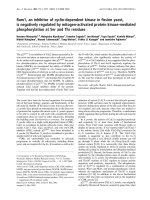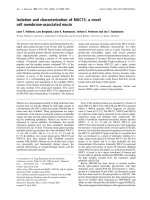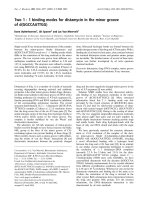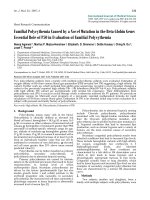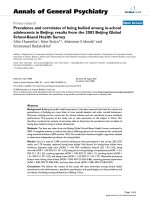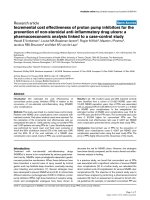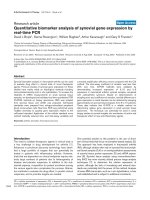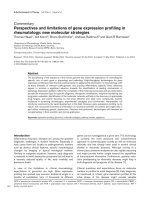Báo cáo y học: "Intraoperative device closure of atrial septal defects in the Older Population" pot
Bạn đang xem bản rút gọn của tài liệu. Xem và tải ngay bản đầy đủ của tài liệu tại đây (1.06 MB, 7 trang )
RESEARCH ARTIC LE Open Access
Intraoperative device closure of atrial septal
defects in the Older Population
Hui Zhang, Qiang Chen, Liang-Wa n Chen
*
, Hua Cao, Gui-Can Zhang and Dao-Zhong Chen
Abstract
Objective: This study sought to prove the safety and feasibility of intraoperative device closure of atrial septal
defect (ASD) with transthoracic minimal invasion in the older patients.
Methods: From January 2006 to December 2009, 47 patients aged 50 years or more and suffered from atrial septal
defect were enrolled in our institution. Patients were divided into two groups, 27 of which in group I with
intraoperative device closure and the other 20 in group II with surgical closure. In group I, the method involved a
minimal intercostal incision, which was performed after full evaluation of the atrial septal defect by transthoracic
echocardiography, and the insertion of the device through the delivery sheath to occlude the atrial septal defect.
Results: In group I, implantation was ultimately successful in all patients. The complete closure rate at 24 hours
and 1 year were 81.5% and 100% respectively. In 6 of 27 patients, minor complications occurred: transient
arrhythmia (n = 5) and blood transfusion (n = 3). In group II, all patients were closured successfully; almos t all of
them needed blood transfusion and suffered from various minor complications though. During a follow-up period
of 1 to 5 years, no residual shunt, noticeable mitral regurgitation, significant arrhythmias, thrombosis, or device
failure were found. In our comparative studies, group II had significantly longer ICU stay and hospital stay than
group I (p < 0.05). The cost of group I was less than that of gro up II(p < 0.05).
Conclusions: Minimally invasive transthoracic device closure of the atrial septal defect at advanced age with a
domestically made device without cardiopulmonary bypass is safe and feasible under transthoracic
echocardiographic guidance. It was cost-savings, yielding better cosmetic results and leaving fewer traumas than
surgical closure. Early and mid-term results are encouraging. However, it is necessary to evaluate the long-term
results.
Background
Atrial septal defect(ASD) is one of the most common
congenital cardiac defec ts and accounts for approxi-
mately 6% to 10% of all congen ital cardiac defects [1,2].
Most of the patients with ASD are usually asymptomatic
and could wait for electiv e surgical or catheter-based
closure for over 3 years. However, due to the poor med-
ical resources and knowledge, some patients with ASD
had not been able to receive the best treatment until
they reached old age. This phenomenon is particularly
prevalent in low-income countries. A lthough transcath-
eter closure with Amplatzer septal occluder and surgical
repair have been reliably achieved with no mortality and
minimal morbidity, [3-6] and the Khan has repo rted a
series of the transcatheter closure in t he older patients,
[7] the catheter-based closure needs"selective and suita-
ble"patients, more advanced equipments and exposure
in X-ray as well. The older patients usually have big size
atrial septal defect and the deficiency of the ASD rim,
thus closing such patients in the catheterization labora-
tory could still be quite challenging. The surgical
method needs the utilization of CPB an d the about
20 cm midline incisions [6]. Meanwhile, since these
patients usually suffer from poor health condition and
mild-moderate pulmonary hypertension, surgery and
CPB for these patients could mean high-risk. With the
recent surge of minimally invasive techniques, our
approach is to use an intraoperative device and a small
incision to close ASD without CPB, which could result
in better cosmetic incisions than open-heart surgery.
* Correspondence:
Department of Cardiovascular Surgery, Union Hospital, Fujian Medical
University, Fuzhou, 350001,P. R. China
Zhang et al. Journal of Cardiothoracic Surgery 2011, 6:123
/>© 2011 Zhang et al; licensee B ioMed Central Ltd. This is an Op en Access article distributed under the terms of the Creative Commons
Attribution License ( which permits unrestricted use, distribution, and reprodu ction in
any medium, pro vided the original work is properly cited.
This technique is simple, easy to learn and cost-accepta-
ble in the low-income nations. The aim of this study is
to evaluate the safety and feasibility of intraoperative
device closure of ASD in the older patients with trans-
thoracic minimal invasion. The results are encouraging
[8,9].
Materials and methods
The present study was approved by the ethics commit-
tee of our university and adhered to the tenets of the
Declaration of Helsinki. Additionally, the written
informed consent was obtained from the patients.
Device
The ASD occluder was modified from the Amplatzer
atrial septal occluder. It was made in Dong Guan Ke
Wei Medical Apparatus Co.Ltd of China. [Figure 1] The
device consists of an occluder made from an alloy of
nickel and titanium, a metal sheath, a pushing rod, and
ahook.Thedoublediscoccluderhasalooponthe
right disc with a 100-cm thread through the loop, facili-
tating its withdrawal into the 40-cm long and 8-10 mm
diameter sheath. The occluder was sel ected in accor-
dance with the corresponding transthoracic echocardio-
graphy result, a maximum defect diameter plus 2-6 mm.
The occluder was loaded into the sheath [8-10].
Patients
The patients were divided into two groups in accor-
dance with th eir own choices of the methods of closure.
No difference in age and body weight distribution was
found in either group. The parti cipants were enrolled in
our institution between January 2006 and December
2009. Those with other coexisting cardiac anomalies
were excluded from our study. Transthoracic echocar-
diography was used to confirm the diagnosis of the
atrial septal defect in those patients and assess the cir-
cumferential margins. Routine examinations included a
standard electrocardiogram, a chest X-ray, and blood
tests. All patients were symptomatic, which included fre-
quent respiratory infection, palpitations, shortness of
breath, exercise intolerance and insignifica nt chest pain.
Indications for the atrial septal defect closure were the
same as those used for surgical closure, which included
hemodynamically significant left to right shunts and (or)
significant chamber enlargement, and (or) mild to mo d-
erate to se vere pulmonary hypertension, despite medical
therapy and (or) history of infective endocarditis.
Group I included 27 patients (15 males and 12
females) with isolated ASD received intraoperative
device closure treatment without CPB. The patients
were aged from 50 years to 65 years (mean ± standard
deviation, 56.5 ± 4.2 years). Their weights ranged from
48 to 75 kg (61.6 ± 7.1 kg). Of all patients, 12 patients
had mild pulmonary hypertension (wh ich was assessed
by TTE, pulmonary artery systolic pressure 30-45
mmHg) . 13 patients had moderate pulmonary hyperten-
sion (pulmonary artery systolic pressure 45-75 mmHg),
and 2 patients had severe pulmonary hypertension (pul-
monary artery systolic pressure 75 to 90 mm Hg). 10
patients were diagnosed as ASD with the inferior vena
cava rim deficiency.
Group II included 20 patients (12 males a nd 8
fem ales) who refused dev ice clos ure and received surg i-
cal closure. Their ages ranged from 50 years to 64 years
(56.6 ± 4.4 years) and their weights ranged from 50 to
72kg(60.3±5.7kg).Ofallpatients,10patientshad
mild pulmonary h ypertension. 9 patients had moderate
pulmonary hypertension, and 1 patient had severe pul-
monary hypertension.
Protocol
In group I, general anesthesia was applied to patients and
then they were placed in a supine position and draped
for exposure of the entire chest with the right hemithorax
elevated to approximately 30 degrees. Intraoperative
transthoracic echocardiography (TTE) was used to assess
the ASD, especially the defect size and circumferential
margins adjacent to the superior vena cava, inferior vena
cava, pulmonary vein, mitral valve, and aortic sinus [11].
The atrial septal occluder was chosen according to the
largest diameter of the ASD, [Figure 2] allowing for a
margin of 2-6 mm in excess of the diameter in patients.
A right anterior submammary minithoracotomy (about 5
cm in length) was made through the fourth intercostal
space. A small rib spreader was used in this manipulation
incision to facilitate instrumentation. The pericardium
was opened and suspended to expose right atrium. In the
anterolateral right atrium, two parallel 4/0 Prol ene
sutures of approximately 15 mm in diameter were
Figure 1 The occlusion devices.
Zhang et al. Journal of Cardiothoracic Surgery 2011, 6:123
/>Page 2 of 7
stitched. Heparin was intravenously given at 1 mg/kg
body weight, and the activated clotting time was moni-
tored to be greater than 250 sec. The occluder was
drawn into the delivery sheath, then a 1 5 mm incision
was opened in the right atrium and the delivery sheath
was inserted. Under continuous TTE guidance, the
sheath was advanced through the ASD into the left
atrium. [Figure 3] The left disc was deployed first by
pushing the rod. Adjusting the left disc to be parallel to
the atrial septum, the sheath was withdrawn, and then
the right disc was deployed on the other side to occlude
the ASD. [Figure 4] A to-and-fro motion of the sheath
was performed to ensure a secure position across the
defect [12,13]. In those patients with the inferior vena
cava rim, the occluder would been easily dislodged back
into the right atrium thought the deficienct inferior vena
cava rim, some new technique were therefore added [9].
During the process of the occluder deployment, the
occluder was moved to the rim of superior vena cava by
moving the sheald as close as possible, then the “left
atrium-occluder-the right atrium” suture through the
junction of the Waterston’s groove and the inferior vena
cava was made in order to fix occluder. After the TTE
evaluated there were no significantly residual shunt, no
atrioventricular valve distortion and no obstruction of the
coronary sinus, the thread was cut and the sheath was
withdrawn with the suture snugly tied. The chest
was closed routinely with a drainage tube placement.
Oral aspirin had been taken for 3 months as an
anticoagulation.
In group II, all patients had been attempted open-
heart repair with a median sternotomy about 20 cm
incision and cardiopulmonary bypass.
Statistical Analysis
Continuous data are given as mean ± standard devia-
tion and range. Clinical parameters between the
two groups were compared with the independent sam-
ples t-test. A p value of < 0.05 was defined as statistical
significance.
Results
In group I, delivery of occluder was successful in all
patients. The size of the A SD as measured by transthor-
acic echocardiography (TTE) ranged from 32 to 42 mm
(mean 36. 5 ± 2.7 mm). The size of the occluder
implanted ranged from 34 to 46 mm, (mean 34.6 ± 4.8
mm) and the diameter of the sheath was 8-10 mm. The
duration of the procedure was in 40-70 minutes (mean
55.8 ± 8.6 minutes). T he intensive care unit stay was
about 10-24 hours(mean 14.2 ± 3.7 hours), and hospital
stay was 6-12 day s (mean 7.7 ± 1.5 days). In those who
had a successful attempt, the overall immediate com-
plete closure rate was 81.5%. A tiny smoke-like residual
flowing through the device or the junction of the occlu-
der and the rim of the ASD were seen immediately after
Figure 2 The 42 mm ASD measured by TTE.
Figure 3 The sheath positioned from the right atrial free wall
into the left atrial cavity across the ASD.
Figure 4 Final image shown after the 44 mm occluder were
deployed and the sheath was withdrawn.
Zhang et al. Journal of Cardiothoracic Surgery 2011, 6:123
/>Page 3 of 7
the procedure was implemented in 5 patients. [Figure 5]
At 3 months, 1 out of 27 patients still have small resi-
dual shunts. Howe ver, the closure rate remained 100%
at 1 year’s follow-up.
Minor complications were encountered in some
patients, including transient arrhythmia(n = 5) in the
course of the device deployment. Temporary sinus bra-
dycardia, atrial premature beats and transient left bun-
dle branch block were observed in these patients
immediately, which were easily treated by drugs or
spontaneous recovery. Immediate postprocedure third-
degree AVB was observed in 1 patient with an ASD
diameter of 40 mm and an occluder size of 44 mm.
Since heart rates were ranging about 50-55 bpm, no
intervention except closed observation was needed.
After treated by glucocorticoid, the AVB resolved
spontaneously after 1 week. 2 patients with post-opera-
tive cardiac arrest were successfully cardiopulmonary
resuscitated. These 2 patients had preoperative left
bundle branch block and atrioventricular block. After
occlusion, transient left ventricular volume overloaded
and slow heart rate may result in cardiac arrest. After
treatment of dopamine and furosemide for several
days, both patients recovered well. 5 patients need to
be retrieved the device several times, which occurred
intheapparentresidualfistulaandthedeficiencyof
the rim. In 3 cases, blood loss requiring transfusion
occurred. Therefore, it is important to prepare plenty
of blood products before the operation starts. Large
pleural effusion occurred in 3 patients and they
were treated with drainage tube placement. 3 patients
developed mild tricuspid regurgitation. There had
been no episodes of endocarditis, thromboembolism,
device disruption or failure, mitral valves distortion,
complete atrioventricular block or permanent rhythm
disturbances.
In those who had a successful attempt, total follow-up
period ranged from 1 t o 5 years (2.5 ± 1.1 years). Out-
patient follow- up was conducted by functional, echocar-
diographic, and ECG assessment. Symptoms had been
either resolved totally or improved significantly in all
symptomatic patients. Those patients with mild-moder-
ate pulmonary hypertension had significantly decreased
as evaluated by the tricuspid regurgitation jet. 2 patients
were still in moderate-severe pulmonary hypertension
after operation and needed long-term drug treatment
such as inhale Iloprost and/or oral Sildenafil . Symptoms
such as palpitations, short ness of breath and exercise
intolerance had been improved significantly in these 2
patients. However, long-term effect needs further fol-
low-up. The overall immediate complete closure rate
was 81.5%. Those patients have small residual shunts
and the position of the shunt w as the junction of the
occluder and the rim of defects or the device itself.
However, the closure rate remained 100% at 1 years’ fol-
low-up. No progressive moderate -severe pulmonary
regurgitation occurred. Neither thromboembolic event
nor other major complications were found during fol-
low-up period. To date, none of the patients in our
group has developed complete heart block or/and mitral
regurgitation. The incision in the chest was minor and
cosmetic.
In group II, all pati ents needed blood transfusion.
Arrhythmia and atrial premature beats were observed in
15 patients, especially during the operation. Some
patients would recover immediatel y while others needed
medicine treatment for 3-5 days. 2 patients had Mobitz
type II or complete atrioventricular block and were trea-
ted with temporary epicardial pacemaking. All of them
eventually resumed sinus rhythm after treated by gluco-
corticoid. 3 patients with large pleural effusion nee ded
place drainage tube. 2 patients suffered from postope ra-
tive serious pulmonary infection and ca rdiac dysfunc-
tion. During follow-up period (2.4 ± 1.1 years), there
were no episodes of ASD residual fistula, hydrothorax,
endocarditis, thromboembolism, or permanent rhythm
disturbances. The incision in the median chest was
about 20 cm.
Table 1 demonstrates the clinical data comparison of
all patients in both g roups. Group II r equired longer
operative time, ICU stay and hospital stay than group I
(p < 0.05). The average total cost in the surgical group
(24084 ± 1219.8 RMB) was higher compared with that
in the device group (20289.9 ± 884.8 RMB) (p < 0.05).
Discussion
Patients with secundum ASD are usually asymptomatic.
However, due to the poor medical resources and knowl-
edge, some patients with ASD have not received
best treatment until they are old. This phenomenon is
Figure 5 Trivial or small residual shunts in the edge of the
occluder which can be ignored.
Zhang et al. Journal of Cardiothoracic Surgery 2011, 6:123
/>Page 4 of 7
prevalent in low-income countries. Elective open-heart
repair with midline sternotomy and cardiopulmonary
bypass has been considered as the golden standard for
the closure of the ASD. Although surgical closure has
been proved safe and effective, it is still associated with
midline sternotomy and cardiopulmonary bypass in a
longer hospital stay. The midline incisions would also
reserve the physical and psychological trauma for the
patients in their future. Meanwhile, there have been
only a few reports about surgical repair of the ASD i n
the older patients until now. In addition, old patients
are usually complicated by pulmonary arterial hyperten-
sion and bad body condition, which means more risk to
surgery and CPB. With the development of various
devices, percutaneous trans catheter occlusions of ASD
gradually become another choice for selected patients,
especially those with secundum ASD. Clinical experi-
ence with device closure of ASD is increasing, and com-
plications seem to be limited in various studies.
Compared with those of surgical approaches, device clo-
sure has the advantage of bringing less discomfort to
patients and leaving no incisional scar. However, due to
the big size or the deficient rim of the ASD of those
older patients, percutaneous approach sometimes could
not be utilized for closure. A certain failure rate percen-
tage exists in those patients with big size or the deficient
rims of ASD, such as residual shunts, subsequent mal-
position and embolization of the device . Furthermore,
due to expensive equipments a nd high cost might be
required, many hospital in the low-income nations have
no resources on developing this technology. Thus, we
applied a minimally invasive technique, intraoperative
device closure of those older ASD patients, imitating
percutaneous closure of ASD.
Closure of ASD is often considered non-beneficial in
older patients because of the lack of experience. Accord-
ing to Khan’s report, [7] transcatheter device closure of
ASD in adults over the age of 40 years is not only safe
and effective, but also results in symptomatic relief by
improving functional class and 6MWT distance with
favorable cardiac remodeling. Our approach may have a
role in a subset of the older patients who have defects
which may be difficult to close percutaneously but have
high risk for surgery closure with CPB. We applied the
same criteria with cardiologists to allow us to choose
the “ suitable” ASD for the device closure in those older
patients. Our recommendations are to use the device
closure in t hose patient with hemodynamically signifi-
cant L-R shunts and/or significant chamber enlarge-
ment, and/or mile-moderate pulmonary hypertension.
The open-chest approach offered an operative field and
allowed the cardiac surgeons to do better with tradi-
tional surgical techniques. Because of the avoidance of
CPB, we could limit the length of incision to about
5 cm. Moreover, it was easy to extend for conversion to
a regular open-heart procedure onc e the in traoperative
device closure failure without additional incisions or
rearranging the operation from the catheterization
laboratory to the operating room, which ensures the
safety of the procedure. The procedure time could be
significantly shortened; the skin-to-skin time could be
limited to 40-70 min. Our method provided a perpendi-
cular angle to the atrial septum, which may result in
more easily deploying the occluder into the defect than
the percutaneous device closure method. A dilemma for
an ASD is choosing the location for the placement of
the occluding device, especially for t he older patients
with big size or the deficient rims of ASD. Since larger
device may interfere with the neighboring structure, the
device size and position must be v erified carefully by
using TTE before and after deployment. The device
selected should be 2-6 mm larger than the ASD, as
measur ed by TTE. When our methods are adopted, it is
advisable to retract the right disc into its sheath and
push the sheath by hand and move the occluder to a
suitable position, and then reopen the right disk. This
process needs to be repeated for many times until suc-
cess during the operation. Based o n our experience ,[8]
the occluder would been dislodged back into the right
atrium, so it’s necessary to observe the location of the
occluder for about 10-20 minutes after the occluder was
released. Sometimes, duri ng th e process of the occluder
deployment, the occluder was moved to the sufficient
rims by mov ing the sheath as close as possible, then the
“left atrium-occluder-the right atrium” suture through
the Waterston’ s groove was made in order to fix the
occluder. Although some patients had small residual
shunts and the position of the shunt was the junction of
the occluder and the deficient rim, endothelialization
would cover the surface of the device and neointima
would form and would fully close any residual shunting
after several weeks.
Transthoracic echocardiography is the primary tool for
detecting ASD. TTE with Doppler study can be used for
Table 1 Comparison of clinical data in both groups.
Group I Group II p value
Number of patients 27 20
Male/female 15/12 12/8
Age (years) 56.5 ± 4.2 56.6 ± 4.4 P > 0.05
Body weight(kg) 61.6 ± 7.1 60.3 ± 5.7 P > 0.05
ASD size(mm) 36.5 ± 2.7 35.9 ± 3.6 P > 0.05
operative time(minutes) 55.8 ± 8.6 99 ± 9.4 P < 0.05
ICU stay (hours) 14.2 ± 3.7 15 ± 4.5 P < 0.05
Hospital stay (days) 7.7 ± 1.5 9 ± 1.9 P < 0.05
Follow-up(years) 2.5 ± 1.1 2.4 ± 1.1 P > 0.05
Total cost (RMB) 20289.9 ± 884.8 24084 ± 1219.8 P < 0.05
Zhang et al. Journal of Cardiothoracic Surgery 2011, 6:123
/>Page 5 of 7
measurement of flow dynamics, assessment of the direc-
tion and magnitude of abnormal flow across an ASD,
and acquisition of the Qp/Qs ratio. Accurate measure-
ment of the size of the defect and surrounding rims by
TTE was essential for intraoperative device closure.
Although as Sheung-Fat Ko has reported that compared
with the findings at cardiac CT and TEE, there are no
significant differences in the three techniques in assess-
ment of the long axis of small ASDs, underestimation of
the long-axis of large ASD was common at TTE [14]. In
our opinion, TTE may afford a good visualization of
ASD and its spatial relations with neighboring struc-
tures. With the experienced operators, TTE is also a
reliable method in quantitating ASD diameters and
guiding device-deployment procedures. Usually, we
choose large size device, so that we don’tconsiderthe
underestimation of the long-axis of large ASD [8,9].
Atrial septal defects with a left-to-right shunt lead to
development or deterioration of volume overload right
ventricular hypertrophy and failure or pulmonary hyper-
tension. Such factors might explain the unfavorable
course in the older patients’ ASDclosure[15].Those
ASD closure might lead to pulmonary congestion or even
edema in the older patients, as well as to aggravation of
right heart failure in those patients with pulmonary
hypertension. Bruch’s report on a series of 15 patients
with advanced age and/or left or right heart fai lure and/
or pulmonary arterial hypertension using fenestrated
ASD occlusion shows that high-risk ASD occlusion can
be safely accomplished with excellent clinical results and
without complications by a fenestrated occluder [16]. In
our study, those older patients with moderate-severe pul-
monary hypertension inhale Iloprost and/or oral Sildena-
fil for 3-6 months before ASD closure [17]. After drug
treatment, our study group had shown significant
improvement in 6MWT distance, which is useful in the
serial evaluation of patient status. The most clinically
relevant finding was the increase in exercise capacity as
indicated by the increase in 6MWT distance. Qp/Qs was
reduced significantly, indicating the reduction in the left-
to-right shunting through the ASD, showing a trend
toward a reduction in the pulmonary, right atrial, and
right ventricular pressure s. Then those p atients receive
device closure and inhale Iloprost and/or oral Sildenafil
for 6 months after ASD closure. Symptoms had been
improved significantly. No progressive severe pulmonary
arterial hypertension and right heart function failure were
detected and long-term effect needs further follow-up.
In our series of study, device closure was successful in
all patients. In those who had a successful attempt, clo-
sure rate was 81. 5% immediately after operation, 100%
at 12 months follow-up. Trivial or small residual shunts
can be ignored immediately after the release of device
since they usually disappeared during follow-up period.
This early shunting was associated with the loose-links
between the occluding device and the rim of de fects or
the device itself. Several weeks later, endothelialization
woul d cover the surface of the device. Neointima would
form and would fully close any residual shunting. Minor
complications were encountered in some patients,
including transient arrhythmias(n = 5) in the course of
the occluder deployment. Temporary sinus bradycardia
and atrial premature beats were observed in these
patients immediately, which were easily treated by medi-
cine or automatic recovery [18]. The atrial septal would
possibly be deformed when the occulder released, which
may temporarily affect the heart conduction system.
The occluder we chose must be large enough to close
the ASD, but not to change cardiac geom etry structure.
When the occlud e gets larger, the atrial septal would be
more easily deformed. If any deformation or interference
of the device were found, redeployment of the device
would have to be undertaken. Reducing intraoperative
stimulus was also beneficial for transient arrhythmias. In
studies involving transcatheter closure, comparison of
successful and unsuccessful deployment revealed a sig-
nificant association b etween the deficiency of the rim
and a large defect diameter with failure of implantation
[19,20]. In our study, we did not encounter failure in
the implantation of the device using intraoperative
device closure of atrial septal defects.
Relatively highe r medical cost always poses a real
challenge in popularizing a percutaneous approach in
the low-income nations. A domestically made device
was chosen so as to maximally reduce the medical
costs. This technique did not need expensive X-ray
machine, and could also be easily mastered and mini-
mized the operative time. However, it is noted that our
study was conducted in low-income countries where
health care resources were limited. This was a nonran-
domized single-center cohort study and was bias asso-
ciated with data collection and the incomplete data for
some patients. As a result of the a bove mentioned 27
successful closure cases, our experience was limited.
Given t he limited number of the older patients, a ran-
domized trial is difficult to pursue. Larger scales of
research are required and longer follow-up are needed
to determine the future research. This study was lim-
ited to one institutio n, and other institutions may find
different results.
The study serves to demonstrate that intraoperative
device closure is technically feasible and can be per-
formed at low risk in the older patients. It had the
advantages of cosmetic results, leaving less trauma than
surgical closure. It therefore should be recommended.
Conflict of interests
The authors declare that they have no competing interests.
Zhang et al. Journal of Cardiothoracic Surgery 2011, 6:123
/>Page 6 of 7
Acknowledgements
None
Authors’ contributions
HZ collected the clinical data and performed the statistical analysis,
participated in the operation and drafted the manuscript. QC participated in
the operation and drafted the manuscript, revised and submitted the paper.
LWC and HC designed the study and performed the operation. DZC,
participated in the operation. GCZ was the technician of echocardiography
for intraoperation TEE surveillance and provided the ultrasound images. All
authors read and approved the final manuscript.
Received: 4 August 2011 Accepted: 29 September 2011
Published: 29 September 2011
References
1. Dickinson DF, Arnold R, Wilkinson JL: Congenital heart disease among
160,480 live-born children in Liverpool 1960 to 1969. Implications for
surgical treatment. Br Heart J 1981, 46:55-62.
2. Hannoush H, Tamim H, Younes H, Arnaout S, Gharzeddine W, Dakik H,
Obeid M, Bitar FF: Patterns of congenital heart disease in unoperated
adults: a 20-year experience in a developing country. Clin Cardiol 2004,
27:236-40.
3. Formigari R, Di Donato RM, Mazzera E, Carotti A, Rinelli G, Parisi F,
Pasquini L, Ballerini L: Minimally invasive or interventional repair of atrial
septal defects in children: experience in 171 cases and comparison with
conventional strategies. J Am Coll Cardiol 2001, 37:1707-1712.
4. Ryan WH, Cheirif J, Dewey TM, Prince SL, Mack MJ: Safety and efficacy of
minimally invasive atrial septal defect closure. Ann ThoracSurg 2003,
75:1532-1534.
5. Pedra CA, McLaughlin P, Benson LN: The role of CardioSEAL and Starflex
Devices in atrial defect occlusion. Curr Interv Cardiol Rep 2000, 2:274-282.
6. Kirklin JW, Barratt-Boyes BG: Atrial septal defect and partial anomalous
pulmonary venous connection. Cardiac surgery. 2 edition. Churchill
Livingstone, New York; 1993, 609-644.
7. Khan AA, Tan JL, Li W, Dimopoulos K, Spence MS, Chow P, Mullen MJ: The
Impact of Transcatheter Atrial Septal Defect Closure in the Older
Population. J Am Coll Cardiol Intv 2010, 3:276-281.
8. Qiang Chen, Liang-Wan Chen, Hua Cao, Gui-Can Zhang, Dao-Zhong Chen,
Hui Zhang: Intraoperative device closure of atrial septal defects with
inferior vena cava rim deficiency; a safe alternative to surgical repair.
J Thorac Cardiovasc Surg 2011, 141:631-636.
9. Qiang Chen, Liang-Wan Chen, Hua Cao, Gui-Can Zhang, Dao-Zhong Chen,
Hui Zhang: Intraoperative device closure of atrial septal defects in
infants. Ann Thorac Surg 2010, 89:1250-1254.
10. Xiang-Jun Zeng, Xu-Fa Chen, Duan Cheng, Xiao-Jing Ma, Xue-Song Hu,
Liang Tao: Peratrial Closure of Atrial Septal Defects without
Cardiopulmonary Bypass. Asian Cardiovasc Thorac Ann 2007, 15:191-193.
11. Li GS, Kong GM, Wang YL, Jin YP, Ji QS, Li JF, You BA, Zhang Y: Safety and
Efficacy of Transcatheter Closure of Atrial Septal Defects Guided by
Transthoracic Echocardography:a Prospective Study from Two Chinese
Medical Centers. Ultrasound in Med. & Biol 2009, 35:58-64.
12. Zhao Q, Sun X, Chen A, Xia L, Wang MDZ: Endoscopy-Guided Occlusion
of Secundum Atrial Defect Permits Use of Smaller, Cosmetically Superior
Thoracotomy. J Card Surg 2009, 24:181-184.
13. Hongxin L, Lijun S, Wang ZJ, Zi J, Zhang WL, Zhang HZ, Wenbin G,
Zou CW: Intraoperative device closure of large secundum atrial septal
defects;a safe alternative to transcatheter closure. European Journal of
Cardio-thoracic Surgery 2008, 33:1055-1060.
14. Ko SF, Liang CD, Yip HK, Huang CC, Ng SH, Huang CF, Chen MC: Amplatzer
Septal Occluder Closure of Atrial Septal Defect: Evaluation of
Transthoracic Echocardiography, Cardiac CT, and Transesophageal
Echocardiography. Am J Roentgenol 2009, 193:1522-1529.
15. Ghosh S, Chatterjee S, Black E, Firmin RK: Surgical closure of atrial septal
defects in adults: Effect of age at operation on outcome. Heart 2002,
88:485-487.
16. Bruch L, Winkelmann A, Sonntag S, Scherf F, Rux S, Grad MO, Kleber FX:
Fenestrated Occluders for Treatment of ASD in Elderly Patients with
Pulmonary Hypertension and/or Right Heart Failure. J Interven Cardiol
2008, 21:44-49.
17. Ghofrani HA, Wiedemann R, Rose F, Olschewski H, Schermuly RT,
Weissmann N, Seeger W, Grimminger F: Combination Therapy with Oral
Sildenafil and Inhaled Iloprost for Severe Pulmonary Hypertension. Ann
Intern Med 2002, 136:515-522.
18. Kalman JM, VanHare GF, Olgin JE, Saxon LA, Stark SI, Lesh MD: Ablation of
‘incisional’ reentrant atrial tachycardia complicating surgery for
congenital heart disease. Use of entrainment to define a critical isthmus of
conduction. Circulation 1996, 93:502-512.
19. Chan KC, Godman MJ, Walsh K, Wilson N, Redington A, Gibbs JL:
Transcatheter closure of atrial septal defect and interatrial
communications with a new self-expanding nitinol double disc device
(Amplatzer septal occluder): multicentre UK experience. Heart 1999,
82:300-6.
20. Du ZD, Koenig MD, Cao L, Waight D, Hertschmidt M, Hijazi ZM:
Comparison of transcatheter closure of secundum atrial septal defect
using the Amplatzer septal occluder associated with deficient versus
sufficient rims. Am J Cardiol 2002, 90:865-869.
doi:10.1186/1749-8090-6-123
Cite this article as: Zhang et al.: Intraoperative device closure of atrial
septal defects in the Older Population. Journal of Cardiothoracic Surgery
2011 6:123.
Submit your next manuscript to BioMed Central
and take full advantage of:
• Convenient online submission
• Thorough peer review
• No space constraints or color figure charges
• Immediate publication on acceptance
• Inclusion in PubMed, CAS, Scopus and Google Scholar
• Research which is freely available for redistribution
Submit your manuscript at
www.biomedcentral.com/submit
Zhang et al. Journal of Cardiothoracic Surgery 2011, 6:123
/>Page 7 of 7
